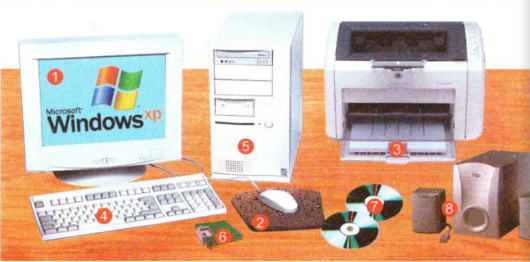Vocabulary
Technology : công nghệ
1.illustration (n) [,iləs’trei∫n]: ví dụ minh họa
-> illustrate (v): minh họa
ex: This picture is lilac ‘s illustration.
2. central processing unit (CPU) (n): thiết bị xử lí trung tâm
3. keyboard (n) [‘ki:bɔ:d]: bàn phím
ex: We use keyboard for typing.
4. visual display unit (VDU) (n) [‘vi∫uəl, dis’plei, ‘ju:nit]: thiết bị hiển thị
5. computer screen [skri:n] (n): màn hình máy tính
ex: If you spend much time looking at your computer screen , you will wear the classes.
6. floppy disk (n):[‘flɔpi] đĩa mềm
7. speaker (n) [‘spi:kə]: loa
->speak (v): nói
8. scenic (a) [‘si:nik] : thuộc cảnh vật
-> scenery (n) : cảnh vật , phong cảnh
9. scenic beauty [‘bju:ti] (n): danh lam thắng cảnh
ex: Ha long bay is one of scenic beaties in Viet Nam .
10. miraculous (a) [mi’rækjuləs]: kì lạ
-> miracle (n): kỳ diệu ,phép màu, sự kỳ lạ
11. device (n) [di’vais]: thiết bị
12. appropriate (a) [ə’proupriət]: thích hợp
-> appropriation (n): sự thích hợp, chiếm hữu
13. hardware (n) [‘hɑ:dweə]: phần cứng
14. software (n) [‘sɔftweə]: phần mềm
15. be capable of doing (sth)(exp.): có khả năng làm (cái gì)
-> be incapable of doing sth: không có khả năng làm (cái gì)
16. calculate (v) [‘kælkjuleit]: tính tóan
-> calculator (n):máy tính
17. calculation (n) [,kælkju’lei∫n]: sự tính tóan, phép tính
18. speed up (v) [‘spi:d’ʌp]: tăng tốc
19. multiply (n) [‘mʌltiplai]: nhân
20. divide (v) [di’vaid]: chia
-> divide into (v) : chia thành
21. with lightning speed [‘laitniη, spi:d] (exp.): với tốc độ chớp nhóang
22. perfect (a) [‘pə:fikt]: hòan thiện
-> perfection(N): sự hoàn hảo
23. accuracy (n) [‘ækjurəsi]: độ chính xác
-> accurate (A) : chính xác
24. electronic (a) [,ilek’trɔnik]: thuộc về điện tử
-> electric (a) : thuộc về điện
-> electricity (n): điện
25. storage (n) [‘stɔ:ridʒ]: sự lưu giữ
-> store (v): lưu trư
-> store (n): cửa hàng
26. data (n) [‘deitə]: dữ liệu
27. magical (a) [‘mædʒikəl]: kì diệu
-> magically (adv): một cách kỳ diệu
-> magic (n): phép thuật
28. typewriter (n) [‘taip,raitə]: máy đánh chữ
29. memo (n) [‘memou]: bản ghi nhớ
30. request [ri’kwest] for leave (exp.): đơn xin nghỉ
31. communicator (n) [kə’mju:nikeitə]: người/ vật truyền tin
-> communicate(v): giao tiếp, truyền tin
-> communication(n) : sự giao tiếp
32. interact (v) [,intər’ækt]: tiếp xúc, tương tác
-> interaction (n): sự tiếp xúc, sự tương tác
33. entertainment (n) [,entə’teinmənt]: sự giải trí
-> entertain(v): làm giải trí
34. link (v) [liηk]: kết nối
35. act on (v) [ækt, ɔn]: ảnh hưởng
36. mysterious (a) [mis’tiəriəs]: bí ẩn
-> mystery (n): sự bí ẩn
ex: His death is mystery!
37. physical (a) [‘fizikl]: thuộc về vật chất
38. invention (n) [in’ven∫n]: sự phát minh
-> invent (v): phát minh
39. provide (v) [prə’vaid]: cung cấp
40. personal (a) [‘pə:sənl]: cá nhân
41. material (n) [mə’tiəriəl]: tài liệu
42. search for (v) [sə:t∫, fɔ:]: tìm kiếm
43. scholarship (n) [‘skɔlə∫ip]: học bổng
44. surf on the net (exp.): lướt mạng
45. effective (a) [i’fektiv]: hiệu quả
-> effection(n): sự hiệu quả
46. capable (a) [‘keipəbl]: có năng lực, giỏi
-> incapable(a): không có năng lực
47. transmit (v) [trænz’mit]: truyền
48. distance (n) [‘distəns]: khỏang cách
49. participant (n) [pɑ:’tisipənt]: người tham gia
50. rank (v) [ræηk]: xếp hạng
51. foreign language (n) [‘fɔrin, ‘læηgwidʒ]: ngọai ngữ
52. electric cooker (n) [i’lektrik, ‘kukə]: nồi cơm điện
53. air-conditioner (n)[‘eəkən’di∫ənə]: máy điều hòa nhiệt độ
54. in vain (exp.) [in, vein]: vô ích
55. instruction (n) [in’strʌk∫n]: lời chỉ dẫn
56. public telephone (n) [‘pʌblik, ‘telifoun]: điện thọai công cộng
57. make a call [kɔ:l] (exp.) : gọi điện
58. operate (v) [‘ɔpəreit] :vận hành
59. receiver (n) [ri’si:və] : ống nghe
60. dial tone (n) [‘daiəl, toun]: tiếng chuông điện thọai
61. insert (v) [‘insə:t] : chèn vào
62. slot (n) [slɔt]: khe, rãnh
63. press (v) [pres] :nhấn
64. require (v) [ri’kwaiə]: yêu cầu
65. emergency (n) [i’mə:dʒensi] :sự khẩn cấp
66. fire service (n) [‘faiə, ‘sə:vis] :dịch vụ cứu hỏa
67. ambulance (n) [‘æmbjuləns]: xe cứu thương
68. remote control (n) [ri’mout,kən’troul]: điều khiển từ xa
69. adjust (v) [ə’dʒʌst]: điều chỉnh
70. cord (n) [kɔ:d] : rắc cắm ti vi
71. plug in (v) [plʌg, in]: cắm vào
72. dial (v) [‘daiəl]: quay số
73. make sure [∫uə] of sth/ that (exp.): đảm bảo
Grammar
Pronunciation (Phát âm): /ʊ/ – /uː/
/u:/:
Ví dụ: through, whose, too, shoe, …
/ʊ/: Đọc âm u rồi dần dần kéo ngắn thời gian đọc u lại;phát âm sử dụng đồng thời đọc âm “u” trong khi miệng hơi “ư”.
Ví dụ: cook, put, pull, foot,…
Nhận biết nguyên âm dài /u:/
– “o” thường được phát âm là /uː/ trong một vài từ thông dụng có tận cùng bằng “o” hay “o” với phụ âm.
Ví dụ: do, move, lose, prove,…
– “u” còn được phát âm là /uː/.
Ví dụ: blue, flute, lunar,…
– “oo” còn được phát âm là /uː/.
Ví dụ: food, cool, tooth, …
– “ou” được phát âm là / uː/ trong một số trường hợp.
Ví dụ: group, wounded,…
– “ui” được phát âm là / uː/ trong một số trường hợp.
Ví dụ: fruit, juice, recruit,…
Nhận biết nguyên âm ngắn /ʊ/
– “o” được phát âm là /ʊ/ trong một số trường hợp.
Ví dụ: wolf, woman,…
– “oo” thường được phát âm là /ʊ/.
Ví dụ: book, good, look, foot,…
– “ou” được phát âm là /ʊ/ trong một số trường hợp.
Ví dụ: could, should, would,…
| /ʊ/ | /uː/ | ||
|
put pull full |
foot look cook |
food school tooth |
fruit June afternoon |
The present perfect
Have you ever + V3/-ed….? Bạn có từng ….?
- Yes, I have.
- No, I haven’t
Thì hiện tại hoàn thành (The present perfect tense)
|
Khẳng định (+) |
Phủ định (-) |
Nghi vấn(?) |
Ví dụ |
|
I/You/We/They/Plural noun + have + V3/-ed
I/You/We/They/Plural noun + has + V3/-ed
|
I/You/We/They/Plural noun + haven’t + V3/-ed
I/You/We/They/Plural noun + hasn’t + V3/-ed
|
Have + I/You/We/They/Plural noun + V3/-ed…?
Has + I/You/We/They/Plural noun + V3/-ed …? |
– I have learnt English for 2 years. – She has lived here since 2010. |
Cách dùng:
- Diễn tả hành động xảy ra trong quá khứ kéo dài đến hiện tại và có thể xảy ra trong tương lai.
- Hành động vừa mới xảy ra.
Dấu hiệu nhận biết: for + khoảng thời gian (for 3 months, for 5 years…), since + mốc thời gian (since 2000, since last month …), recently, just (vừa mới), already (đã rồi), ever (đã từng), never (chưa bao giò), lately (gần đây), so far , up to now, up to the present (cho tới bây giờ), this is the first time / the second time / the third time (đây là lần đầu tiên …)
Ex: I have just come home.
She has never gone to New York.
We have already done our homework.
Have you ever ridden a camel?
- Yes, I have.
- No, I haven’t
Câu bị động ở thì hiện tại hoàn thành
Công thức:
S + has/have + been + V (past participle) + by + O
Ví dụ:
My bike has just been repaired by my father.
Who
“Who” được sử dụng khi tiền ngữ chỉ về người và làm chủ từ của mệnh đề tính từ.
Ví dụ: The boy who played with me last Sunday is my younger brother.
Which
“Which” được sử dụng khi tiền ngữ là từ không chỉ về người, có thể làm chủ từ hoặc túc từ của mệnh đề tính từ.
Ví dụ: The cat which has been bought by Susan is standing my chimney!
That
“That” được sử dụng khi tiền ngữ là từ chỉ về người, hay không về người, và có thể làm chủ từ hoặc túc từ.
Ví dụ: The girl and her cat that are running around has been stolen their bag.
Reading
BEFORE YOU READ
Work in pairs. Look at the illustrations of different parts of a computer system. Match each numbered item with one of the words or phrases in the box.
(Làm việc theo cặp. Nhìn hình minh họa của những phần khác nhau của hệ thống máy vi tính. Ghép từng phần có ghi số với một trong, những từ hoặc cụm từ trong khung.)
|
A. central processing unit (CPU) B. CD ROMs C. keyboard D. visual display unit (VDU) or computer screen E.mouse F. floppy disks G. printer H. speakers |


1.D 2. E 3.G 4.C
5.A 6.F 7. B 8. H
Translate :
1. thiết bị hiển thị (VDU) hoặc màn hình máy tính
2. chuột
3. máy in
4. bàn phím
5. Bộ phận xử lý trung tâm (CPU)
6. đĩa mềm
7. CD ROM
8. loa
WHILE YOU READ
Read the passage and then do the tasks that follow.
(Đọc đoạn văn và sau đó làm bài tập sau.)
Translate
Máy tính đã và đang trở thành một phần trong đời sống hằng ngày của chúng ta.Với sự trợ giúp của máy tính ta đến các cửa hàng, cơ quan, các danh lam thắng cảnh. Ta thanh toán hóa đơn bằng máy tính. Chúng ta có thể đọc báo và tạp chí xuất bản trên máy tính. Chúng ta có thể nhận và gửi thư đến hầu hết mọi nơi trên thế giới này nhờ vào máy tính. Hơn thế, chúng ta có thể học ngoại ngữ bằng máy tính.
Vì đâu mà máy tính trở nên một thiết bị kỳ diệu đến thế? Mỗi khi chúng ta bật máy tính có cài đặt phần cứng và phần mềm thích hợp, nó có khả năng thực hiện hầu hết bất cứ điều gì mà bạn yêu cầu. Nó là một công cụ tính toán có thể thực hiện rất nhanh các phép tính cộng, trừ ,nhân, chia với tốc độ ánh sáng và độ chính xác hoàn hảo.
Nó còn là một thiết bị lưu trữ điện tử quản lý những tập dữ liệu lớn. Nó là máy đánh chữ thần kỳ cho phép bạn đánh chữ hay in bất kỳ loại văn bản nào – thư từ, bản ghi nhớ hay đơn xin phép nghỉ. Nó là một công cụ giao tiếp cá nhân giúp bạn tương tác với những máy tính khác và với mọi người trên thế giới. Và nếu bạn thích giải trí, bạn có thể thư giãn bằng cách chơi trò chơi điện tử hay nghe nhạc được cài sẵn trong máy tính.
Task 1
The words in A appear in the reading passage. Match them with their definition in B.
(Những từ ở cột A xuất hiện trong bài đọc, ghép với định nghĩa của chúng ở cột B.)
Đáp án
1. c 2. e 3. a 4. b 5. d
Translate:
1. magical: kì lạ , bí ẩn (nhiệm màu)
2. places of scenic beauty: danh lam thắng cảnh
3.interact: liên kết , tương tác
4. software: chương trình do máy tính thực hiện (phần mềm)
5. hardware: phần vật lý của hệ thống máy tính (phần cứng)
Task 2
Decide which of the three options below is the best title for the passage?
(Quyết định ý nào trong ba chọn lựa dưới đây là tiêu đề tốt nhất cho đoạn văn?)
A. The Computer – Am New Invention
B. The Computer Has Become Part of Our Life
C. What Can the Computer Do?
Đáp án
C . What Can the Computer Do?
Translate
A. Máy tính – Một phát minh mới
B. Máy tính đã trở thành một phần của cuộc sống của chúng ta
C. Máy tính có thể làm gì?
Task 3
Work in pairs. Answer these questions, using the cues below.
(Làm việc theo cặp. Trả lời những câu hỏi này, dùng từ gợi ý dưới đây.)
1. What can a computer do to help us in our daily life?
visit, pay, read, receive, send, learn
2. Why is a computer a miraculous device?
capable of a calculating machine, an electronic store, a magical typewriter, a personal communicator, for entertainment
Hướng dẫn làm
1.What can the Computer do to help us in our daily life?
⟹ It can help us: visit shops, offices, and places of scenic beauty; pay bills; read newspapers and magazines; receive or send letters to friends and even learn foreign languages …
2.Why is a computer a miraculous device?
⟹ It is a miraculous device because is capable of doing almost anything you ask; it can speed up the calculations. It is an electronic store of data, a magical typewriter and a personal communicator to interact with other computers and with people the world over.
Speaking
Task 2
Work in pairs. Complete the sentences below. Use the words in the box. (You will have to use some verbs more than once.)
(Làm việc theo cặp. Hoàn thành các câu dưới đây. Dùng từ trong khung. (Bạn sẽ phải dùng một số động từ nhiều hơn một lần.))
Đáp án
1. store 2. transmit 3. process
4. send 5. hold 6. make
7. send 8. receive 9. design
Task 3
Look at the ideas in Task 2. then rank them in order of importance. Give reason (s)
(Nhìn vào những ý ở trong Bài tập 2, và sau đó xếp hạng dựa theo tính quan trọng. Đưa ra lý do.)
Hướng dẫn giải:
1. Storing very large amounts of information.
2. Receiving or sending all kinds of information quickly.
3. Processing all information as soon as we receive it.
4. Sending messages from one computer to another.
5. Managing and holding long-distance meetings in which the participants can see each other on screen.
6. Making use of central store of information.
7.Designing houses, bridges, gardens and buildings.
8. Sending or receiving TV programmes to or from other countries.
Task 4
Work in groups. Talk about the uses of information technology. Use the information above.
(Làm viêcj nhóm.Nói về những cách sử dụng công nghệ thông tin. Dùng những thông tin ở trên.)
Conversation 1:
A: Is information technology very important for our lives?
B: Yes, I think so because
– it helps us store …
– it allows us to transmit …./ process ….
C: Yes, I think so because
– it helps us send …
– it allows us to make …./hold ….
LISTENING
BEFORE YOU LISTEN
How often do you use each of the items below? Put a tick (✓) in the right column. Then compare your answers with a partner.
(Bao lâu em sử dụng mỗi món đồ dưới đây một lần ? Đánh (✓) cột đúng. Sau đó so sảnh câu trả lời của em với câu trả lời của bạn cùng học.)
Hướng dẫn giải:
|
|
very often |
sometimes |
never |
|
radio |
|
|
✓ |
|
cell phone |
|
✓ |
|
|
camcorder |
|
|
✓ |
|
computer |
✓ |
|
|
|
TV |
✓ |
|
|
|
fax machine |
|
|
✓ |
WHILE YOU LISTEN (Trong khi nghe)
Tapesript
Well, I wasn’t worried when my son bought a computer. After all lots of children have parents who don’t understand computers. But when my secretary asked me for a computer in the office, I really became worried. So I decided to take some lessons in computing and my son became my teacher. He’s very helpful. He invited me to sit down in front of the computer screen which I did not know what to call it. When I asked him what it was, he said that it was VDU. I still didn’t know what VDU was, but I was too shy to ask him any more. From that moment my memory refused to learn because he told me a lot of things that I really didn’t understand at all. After a few lessons I began to feel tired. I made an excuse, saying that I was having a headache. I suggested we should leave the lesson until another day. Since then I haven’t said anything about the computer to my son and my secretary.
Task 1. Lisien to an old company director talking about his experience of learning how to use a computer. Decide whether the statements are true (T) or false(F).
(Lắng nghe vị giám đốc thâm niêncủa một công ty nói về kinh nghiệm của ông về học sử dụng máy tính. Xác định xem phát biểu nào là đúng (T) hoặc sai (F).)
| T | F | |
|
1. The man was worried when his son bought a computer. |
||
|
2. The man became worried when his secretary asked him to buy a computer. |
||
|
3. The man decided to take some computing lessons. |
||
|
4. His son didn’t understand about the computer. |
||
|
5. The man understood the lessons very well. |
||
|
6. The man continued to learn how to use a computer after a few lessons. |
Đáp án
| T | F | |
|
1. The man was worried when his son bought a computer. |
✓ | |
|
2. The man became worried when his secretary asked him to buy a computer. |
✓ | |
|
3. The man decided to take some computing lessons. |
✓ | |
|
4. His son didn’t understand about the computer. |
✓ | |
|
5. The man understood the lessons very well. |
✓ | |
|
6. The man continued to learn how to use a computer after a few lessons. |
✓ |
Listen again
Đáp án
| 1. invited | 2. still | 3. refused | 4. excuse | 5. anything |
WRITING
Writing instructions
Task 1
Read the following set of instructions on how to use a public telephone
Task 2
Work in pairs. Find out the connectors and the imperative form of the verbs from the instructions.
Đáp án
Connectors: First, Next, Then, Until
Verb in command form: make sure, lift, listen, insert, press, wait, dial
Task 3
Work in groups. Look at the TV and the remote control below, and answer the following questions.
1. What do you have to make sure if you want to operate the TV with the remote control?
-> Hmm , the remote must be the same brand as the TV and TV has electricty, remote has batteries!
2. What should you do if you want to turn on or turn off the TV?
-> I press ‘ POWER’ button.
3. What should you do if you want to select a programme?
-> I choose ‘Menu/programme’ button.
4. What should you do if you want to watch VTV1, VTV2, VTV3, and VTV4?
-> I press button 1 ,2,3,4.
5. What should you do if you want to adjust the volume?
-> I press VOLUME button up or down.
6. What should you do if you don’t want to hear the sound?
-> I press the ‘MUTE’ button.
Task 4
Write a set of instructions on how to operate a TV with a remote control. Use the picture and the questions above as suggestions. You may begin with:
(Viết lời chỉ dẫn về cách điều khiển tivi với thiết bị điều khiển từ xa. Sử dụng bức tranh và các câu hỏi ở trên như là gợi ý. Bạn có thể bắt đầu với:)
If you want to operate a TV with a remote control make sure the cord is plugged in and the main is turned on.
To turn on the TV, press the ‘POWER’ button, to turn it off, press this button again.
To select a programme, press the ‘PROGRAMME/MENU’ button. to watch VTV1, press button number 1; and to watch other channels, press the corresponding button numbers VTV2/3/4. To adjust the volume, press the VOLUME button up or down. And if you don’t want to hear the sound, press the MUTE button.










No Comments
Leave a comment Cancel